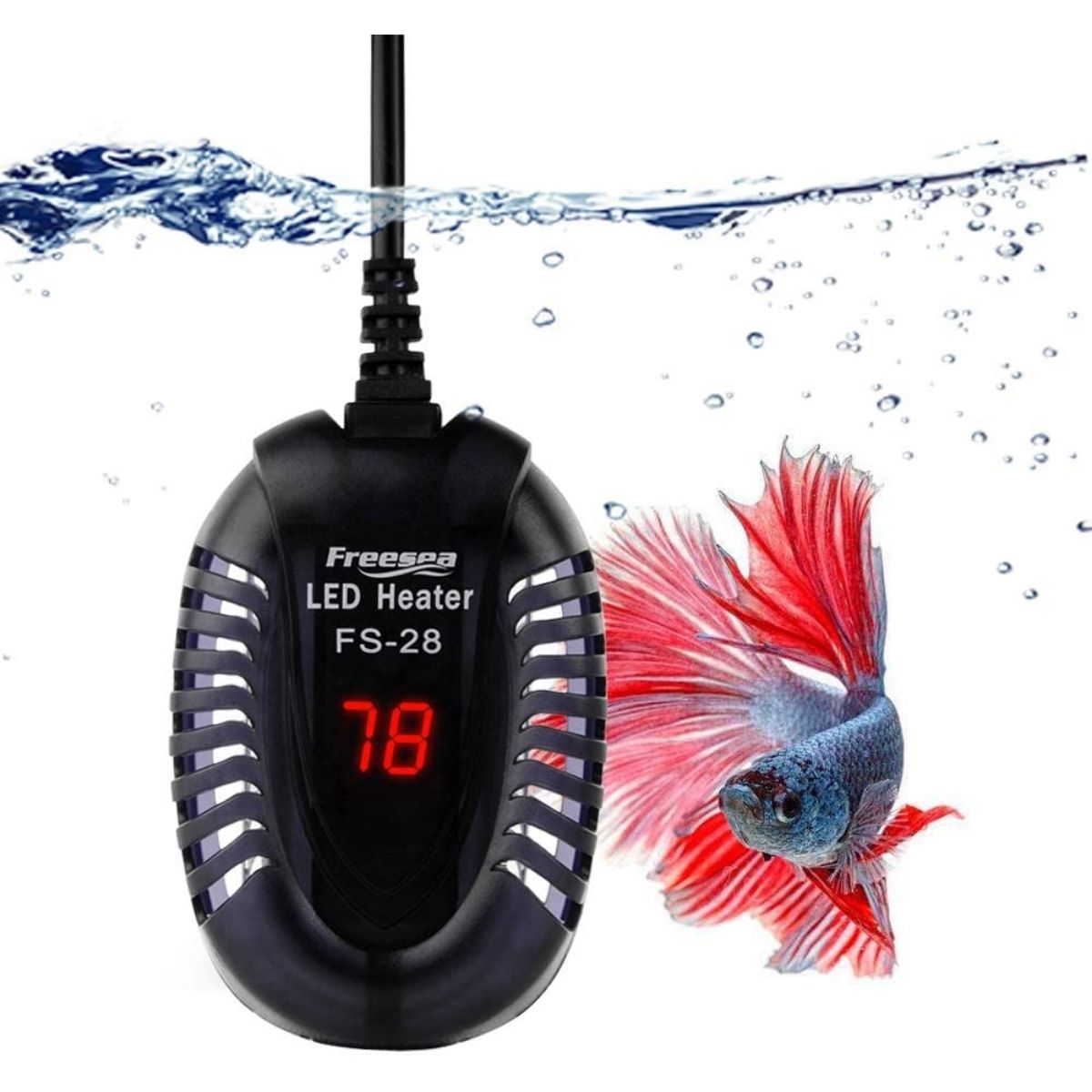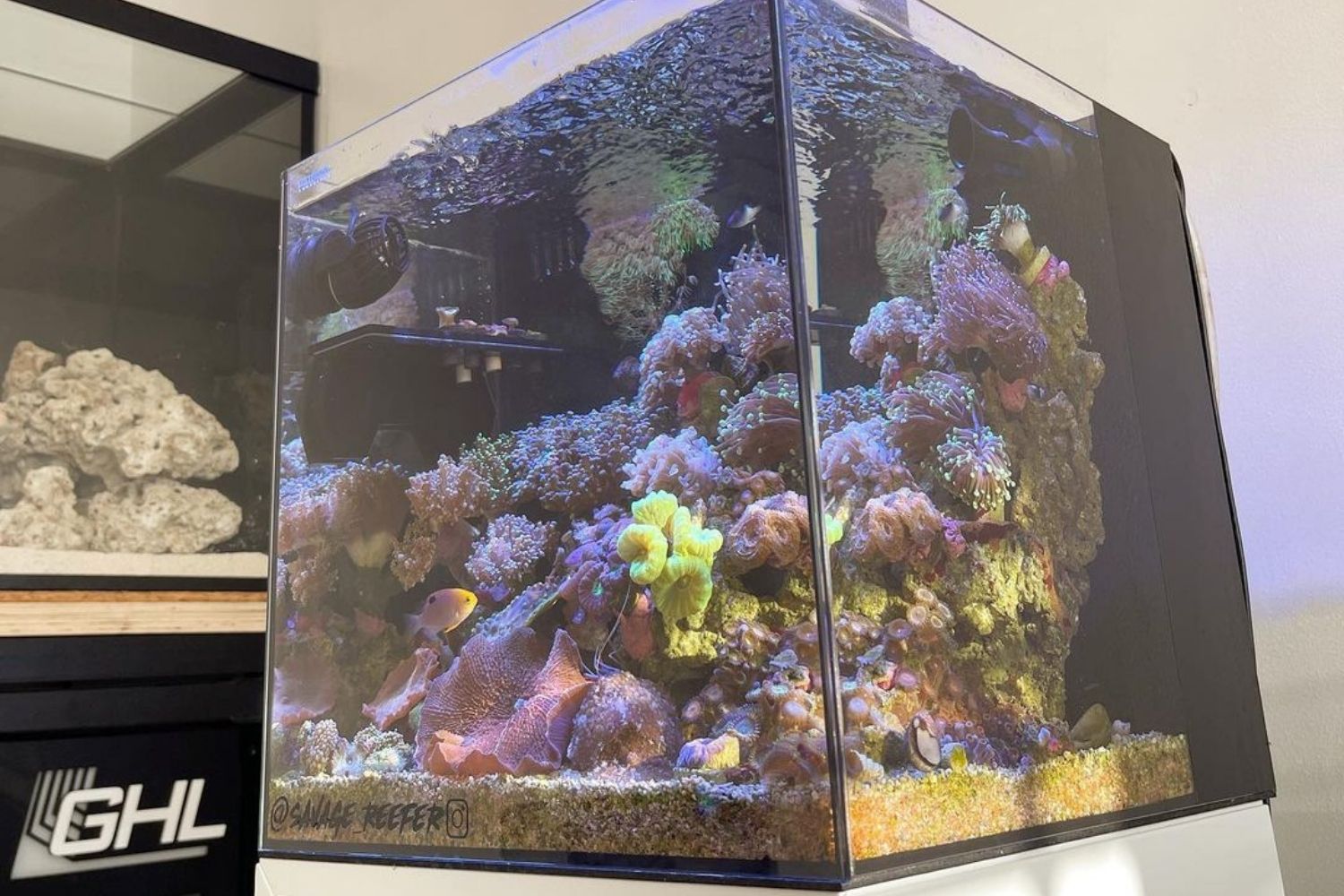Setting up a saltwater aquarium is pretty hard, but with our experience and a lot of researches, we have come up with the basic things that you should know. Is quite difficult to start on your own, and this article is the perfect guide.
First, you will get to know the types of saltwater aquariums, how to set it up and tips to choose the proper fish and plants. I will guide you through the whole process with my easy-to-follow guide.
Types of Saltwater Tanks
Saltwater aquariums come in various types and can make your decision on the best fish tank hard. They have different designs, and what makes them beautiful is the diversity that you choose to keep. The tank is important to have a modern design, if you have only fish, go for a tank with a great display. If you want to keep a reef tank, you can choose a simple one.
If you go for reef tanks, you should know that they are expensive and require extra costs of maintenance. If you are a beginner, only fish or only fish with live rocks would be the perfect one to start with, which can be inexpensive.
Reef Tank
The reef aquarium is probably the most attractive type of aqua space. If you choose this type of tank you will need sea coral and coral fish to enchant your aqua space. It is definitely a challenging thing for beginners, because of their requirements. Lightning and water quality are vital for corals and the parameters should be checked frequently. Another thing that you should know about this tank is that is very expensive and needs extra equipment.
Fish Only
Fish only is best for those who want a cheap saltwater tank setup. If you love fish, and only fish, why bother yourself with buying other things. If you are a beginner in this hobby, learning how to make a fish tank with only fish is probably the easiest type of saltwater tank.
Fish Only With Live Rocks
Fish only with live rocks tanks are also known as FOWLR type of tanks and are quite easy to maintain. This type of reef tank is suggested for fish that are aggressive since they tend to pick on other fish, plants, eat corals or anemones, crustaceans like shrimp and crabs, etc. However, you can keep peaceful fish with live rocks as well to create a beautiful and simple aqua space. This type of tank is cheaper than reef tanks and is an easy saltwater tank setup for beginners.
Essential Saltwater Aquarium Equipment
Setting up a saltwater aquarium is a big deal due to the variety of tasks and requirements. First, you should consider some aquarium equipment that is essential for your saltwater fish, plant and coral. Building a home aquarium may seem easy, but is relatively difficult when planning for a saltwater one.
Here are some of the essential aquarium equipment for your saltwater tank setup:
Aquarium Stand
An Aquarium stand is very important when choosing to set up a saltwater aquarium. There is plenty of saltwater fish that are large in size and very active swimmers. Therefore, there are aggressive fish, with tough temperaments and territorial, on the other hand, there are also the diggers, who like to rearrange the tank time by time. Considering all the above, the stand is important, especially when talking about large tanks.
A stand has its main role to fixate the tank but it also makes room for any aquarium supply, this way you will not make a mess. However, a stand is very important if you choose an acrylic tank since they are lightweight, and might move if you choose large aggressive fish.

Aquarium Filter
An aquarium filter is another essential piece of equipment that you should have in the saltwater tank setup checklist. Most saltwater fish require e clean water, and the filter system will keep the water clean and clear. A good filtration system is very important and it consists of three stages.
The filter is divided into removing the biological excess, but also for chemicals. A carbon filter would be perfect to clear the water from dangerous chemicals. It can be a sump, internal chamber, or a hang-on back filter to keep your tank clear. Mechanical filtration is one of the stages that removes the large particles, any floating waste, and food excess.

Multi-stage filtration
With rotating bio-wheel
Reliable and effective
Up to 70 gallons
Aquarium Heater
Saltwater aquariums require a temperature range of 75 – 80°F (23.5 – 26.5°C). To maintain this temperature is quite difficult, especially in a large tank, that is why you will need a heater. The aquarium heater is even more important when you’re planning to have a tropical fish tank. You should pay attention to the temperature ranges and heat the water when cold, especially if you have a glass tank.

Easy to use and safety
Range: 59~94°F
Up to 15 gallons
Temperature display
Setting Up a Saltwater Aquarium
Excited about setting up your first saltwater aquarium? Most probably you have built the tank by yourself or have chosen one of the best fish tanks we have reviewed. Make it ready and follow our steps to set it up in the right way.
1. Choose the Right Equipment and Position for the Tank
First thing first, you should consider some aquarium equipment that is essential. Based on the fish that you choose, if you want to keep corals or not, any plants or whatever, everything counts. You will need a filtration system, a heater, and an aquarium stand to begin with. Make sure your tank does not have any leaks, add some water and leave it for about an hour to check-in. After this, rinse the water and position of the tank in the place you want to.
Your fish tank shouldn’t be In direct sunlight as it can incense the water temperature during the day. Unsuitable water temperature can damage your coral and plants or even cause death to your fish.
2. Add Accessories & Substrate
The accessories might be artificial plants, rock, woods, or anything else that can be glued to the bottom of the tank. This should be done while the tank is dry. After this, you can add the substrate, sand, or gravel, depending on what you choose. Make sure you rinse the sand to keep your water clear when you fill it.
3. Clean Equipment
When buying the tank and the equipment, no matter if they are new or already used, you should clean them all. They can contain dangerous chemicals, and also pests if used before. You wouldn’t want a polluted tank as your first tank. You should take your time to clean all the equipment such as filter, heater, automatic fish feeder, etc.
4. Install Equipment
First, make sure you have enough space to put them on because after you fill the tank with water you will have a hard time replacing them. If you bought an all-in-one saltwater aquarium kit, this step will be a lot easier for you. The heater is best placed close to the filter or other pump in order to distribute the heat better. It is best to put it horizontally in order to heat the tank faster.
Make sure you choose the proper lighting for your tank, as the fish or plant requires. Adjust the light cycle as natural as possible, mimicking the natural light of the species’ requirements that will live in the tank.
5. Fill It with Saltwater
After you complete all the above steps, fill the tank with reverse osmosis de-ionized water (RODI). Carefully fill it so you don’t stir the sand or gravel, you can put a plate to the substrate for a better result. Also don’t forget to add the aquarium salt, and the dechlorinator. You cant add salt to your aquarium water like you are going to cook spaghetti.
You must have a refractometer to be able to measure the salinity of the water. Saltwater aquarium salinity must be kept between 1.020-1.028sg. If you are feeling stressed about all of this chemistry you can purchase saltwater aquarium water at your local store, that’s an easy way of doing it.
6. Put the Fish and Live Plants.
It is IMPORTANT to place the fish and the live plants 48 hours after the aquarium setup. The aquarium should run for at least 48 hours in order to create the proper environment to welcome the fish and plants.
Therefore, consider acclimatizing them before this procedure by turning off the lights, leave the bad of fish floating in the tank for about 15 minutes then open the bag, add some water from the tank every 4 or 5 min to match the temperatures. Rinse the water of the bag (not in the tank), then repeat the procedure 2 times.
Congratulations, your new saltwater tank is ready.
Saltwater Aquarium Fish for Beginners
Saltwater aquariums are quite easy to maintain, but not reef aquariums or some other fish that require high maintenance. Setting up a saltwater tank is not a big deal now that you have all the instructions above, although, you should consider finding fish that are easy to maintain.
We will tell you what you should know first, in order to choose the best saltwater fish. But first, let’s take a look at some questions that you need to ask before choosing marine fish.
- Which are the easiest fish to keep?
- Will the fish eat live plants or corals?
- Which fish are best for large saltwater tanks?
- Does these fish like groups or prefer to live alone?
When choosing saltwater aquarium fish, there are some low-maintenance fish that you should consider as a beginner in this hobby. The easiest fish to take care of is Auriga Butterflyfish, Racoon Butterflyfish, True Percula Clownfish etc. If you are planning to maintain a reef aquarium and choose corals, Candy Cane Corals is your best choice since they are very easy to keep. As for delicate plants, be careful if you are planning to buy saltwater snails, as they can eat them.

Although, something that you should care about when choosing a fish, is the size of the tank. If you are planning to keep a small tank, consider choosing Blue Green Reef Chromis, Orange spotted Gobby, etc. Flame Angelfish is another easy one to keep, but it has to be separate from other fish unless the tank is large enough. As a beginner, we suggest staying away from the Tang species.
We kept Powder Blue Tang in our saltwater aquarium and it was not that easy to maintain. Although Pink Spotted Watchman Goby, and Coral Beauty Angelfish are perfect if you are planning a reef aquarium, they don’t tend to pick on plants and corals, and can live in a community.
Enjoy your new saltwater aquarium. Comment below and let us your experience with your new saltwater tank.
Frequently Asked Questions
There are hundreds of questions that I get every day from people who are just starting to keep a saltwater tank, getting inspired from them here are the most frequently asked questions about the saltwater tank setup.
Q: How Much Does It Cost to Start a Saltwater Aquarium?
A: To start a saltwater aquarium is required an average of 300$ to 500$. Meanwhile, reef tanks are more expensive.
Q: Are Saltwater Fish Tanks Hard to Maintain?
A: No, is not hard to maintain if you follow some basic instructions.
Q: Do Saltwater Tanks Need Heaters?
A: Yes, saltwater tanks need heaters, although depends on the fish or plant requirements.





